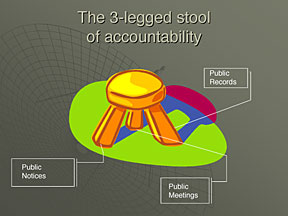Is New York the Wild West of public notice?
Public Notice Resource Center & NNA
Aug 1, 2023
The New York Times reported last month (https://bit.ly/47bCd7a) on several incidents in which public officials revoked public notice contracts “in an effort to punish their hometown newspapers for aggressive coverage of local politics.” The story included two recent cases in New York state.
New York isn’t the only place where public officials sometimes seek to retaliate against those they perceive as enemies. But the state’s folkways and traditions, along with its arcane and antiquated public notice statutes, often result in the chaotic administration of the law.
The Times’ story focused primarily on Delaware County, New York, where officials punished a local newspaper based in the county seat of Delhi. After pulling its notices from The Reporter in favor of a newspaper with less than half its circulation, the county sent the paper a letter (https://bit.ly/3YeuyRo) alleging its articles “are written in an inflammatory manner” and include “editorial remarks ... made to put a negative light on the County government.
“(T)he manner in which your paper reports county business was one of the reasons the Board of Supervisors opted to change the official county paper,” the county explained.
The First Amendment to the U.S. Constitution prohibits the government from retaliating against media outlets for expressing a viewpoint government officials disagree with. So in a sense, Delaware County’s letter was an admission of guilt. Yet, over 40 local officials, including the county attorney and the acting district attorney, affixed their signatures to it.
The Times also cited a case in Ulster County, where the local school district in Ellenville, New York, canceled the Shawangunk Journal’s public-notice contract (https://bit.ly/3DAIH1U) “after several years of gripes about its coverage.” When the contract came up for renewal in 2019, one of the school board members argued the Journal should be dropped (https://bit.ly/3Ya6r6o) because “it had been critical and negative toward the school district.” Although the board voted then to renew the contract, last summer, it decided to move its notices to Alden Global Capital’s Daily Freeman, which is based 30 miles outside of Ellenville and “doesn’t regularly cover its school board meetings,” according to the Journal.
Diane Kennedy, president of New York News Publishers Association, says the events in Ellenville and Delaware County aren’t particularly unusual. “There’s a long tradition of public officials in New York using the threat of withdrawal of public notice advertising to punish newspapers for unfavorable coverage.”
That tradition goes back to at least the early 1960s, when Albany County was controlled by a Democratic machine that ruled the Capital District for about 60 years, ending with the death of Mayor Erastus Corning II in 1983. Shortly before he died during his 41st year in office, Corning told Albany native and Pulitzer Prize-winning author William Kennedy that longtime party boss Dan O’Connell made the decision to punish the local dailies by pulling their public notice ads sometime after the papers were consolidated under Hearst ownership. Corning’s admission was published in O Albany! (https://bit.ly/3OwvddJ) — Kennedy’s history of the capital city.
New York has three separate statutes that largely define how public notice laws must be administered at the local level. The General Construction law (https://bit.ly/45ohBXJ) requires newspapers to have a “paid circulation” and a U.S. Postal Service Periodical permit to publish notices. The other statutes define the powers of the legislative bodies that govern counties (https://bit.ly/3OwBciG) and towns (https://bit.ly/3rEvNwT). Taken together, these laws are often confusing and inconsistent, in part because they were written in a previous era when newspapers frequently were partisan and many municipalities had several to choose from. For instance, the county law requires boards of supervisors to select two official newspapers “representing each of the two principal political parties into which the people of the state are divided” for some notices, but not for others.
Albany County’s notices are currently published by Hearst’s daily, the Times-Union, and The Evangelist (https://bit.ly/3OeYQi9), a weekly newspaper that serves as the official publication of the Catholic Diocese of Albany. According to Stephanie Zebrowski, business manager of The Evangelist, the county has selected the publication to serve as an official newspaper every year for at least the past 20 years. Unlike many other states, newspapers associated with religion are qualified to publish notices under New York law.
Zebrowski says The Evangelist has a Periodical permit and qualifies as a paid-circulation newspaper, even though the paper is mailed free of charge to the homes of local parish members. She says the subscription fees are subsidized by local parishes.
Newspapers that operate under a more conventional free-circulation model also serve as official newspapers in some counties in New York. For example, Sun Community News (https://bit.ly/47cZHsD), which distributes seven targeted circulation newspapers throughout northeastern New York State and western Vermont in the Adirondack region, publishes notices for Essex, Clinton and Warren counties.
Sun Community News President and Publisher Emeritus Dan Alexander says his papers were “grandfathered” under New York’s General Construction law. That law stipulates that publications “designated and publishing notice as an official newspaper” prior to 1940 qualify to publish notices as long as they continued to serve without interruption as an official newspaper until 1975. Alexander claims the predecessor papers to Sun Community News’ current brands meet that qualification.
“We have proposed legislative changes to the public notice laws to bring them up to date, but the legislature has failed to adjust to the changing times,” says Alexander. “With declining circulation in the newspaper business, some municipalities have been forced to find creative ways to run notices in papers that reach their constituents, knowing they had no other available options.”
Alexander isn’t the first to suggest such changes. In fact, a 1969 article in the Cornell Law Review (https://bit.ly/47lpRJM) recommended that the state legislature clean up the statutes and bring them up to date. “Present New York publication requirements reveal little consistency of approach and seem ill-designed to accomplish their purpose,” wrote the authors. “An examination of representative statutory provisions exposes current deficiencies and suggests the need for a simplified and uniform statutory structure.”










